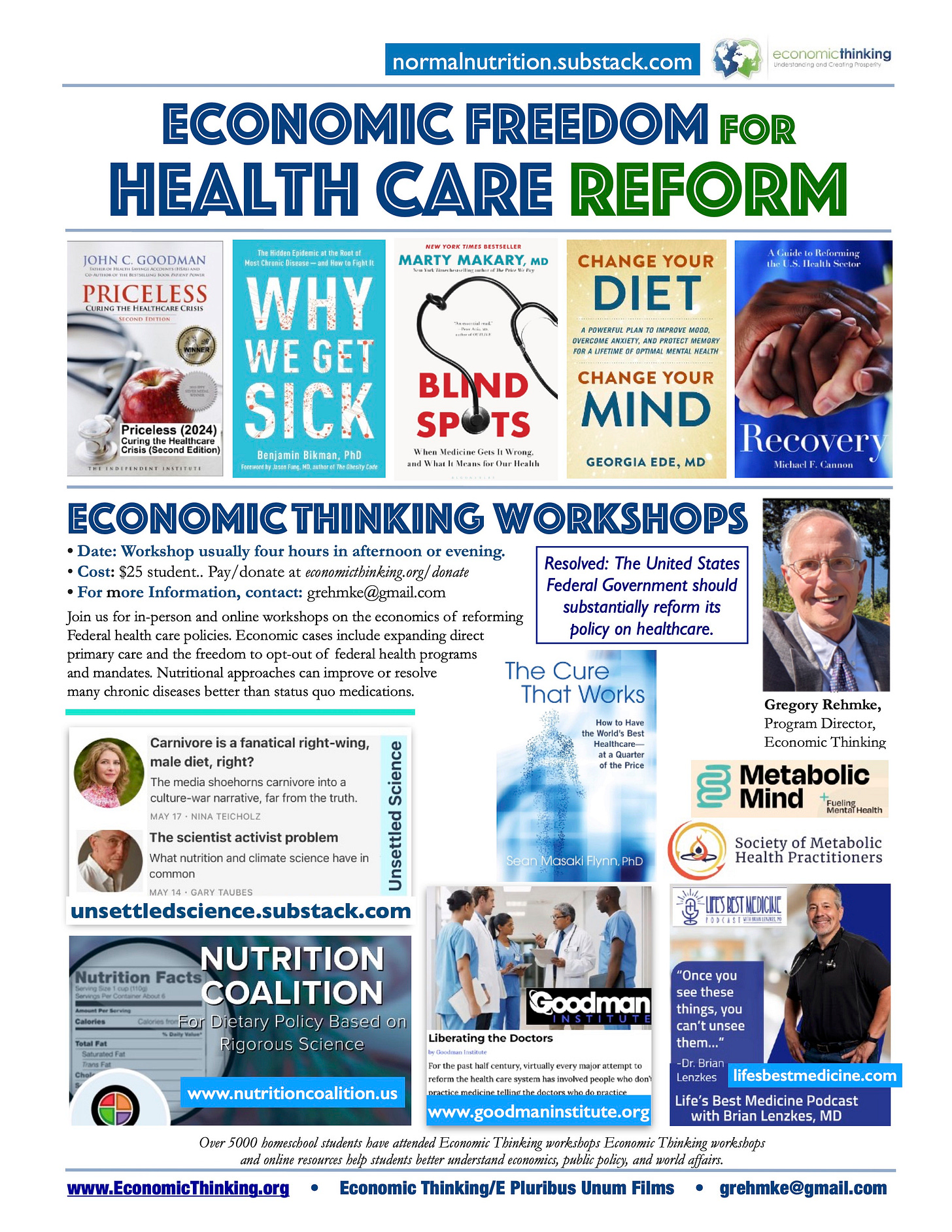Friday, January 10, I was guest on the LowCarbMD Podcast. I greatly enjoyed discussing metabolic health and homeschool debate with hosts Dr. Tro Kalayjian and Dr. Brian Lenzkes. (not sure when the episode will be online.) I’ve been listening to LowCarbMD podcasts since 2020, and I see it’s rated #1 on FeedSpot’s 15 Best Low Carb Podcasts.
But, why listen to podcasts on low-carb “fad diets”? Why not focus on the Standard American Diet (SAD), or the Harvard Health version of the Mediterranean Diet (MedDiet), or some other “heart healthy” diet? Turns out what’s called low-carb today is what Americans used to eat. It’s normal nutrition. The Normal American Diet.
I chose NormalNutrition for this Substack after hearing Nina Teicholz mention that what’s today called “low-carb” is what most Americans ate before the 1970s public health campaign pushing low-fat Federal Dietary Guidelines. More Americans enjoyed bacon and eggs for breakfast, butter not margarine, and whole fat milk, cream and more red meat (beef). From 1970 to 2014 Americans, followed the dietary guidelines down the low-fat rabbit hole.
You can get a sense of nutrition sources public health officials prefer by the looking at the image below from the official website (and reading what is recommended). The claim: ‘The U.S. Departments of Health and Human Services (HHS) and Agriculture (USDA) work together to update and release the Dietary Guidelines every five years. Each edition of the Dietary Guidelines reflects the current body of nutrition science.” Colorful carrots!
The NutritionCoalition (featuring fruit with vegetables on their homepage) assembles nutritional research skeptical of Federal Dietary Guidelines health claims, noting America’s obesity epidemic began when the low-fat Dietary Guidelines started guiding the public away from saturated fats and toward more carbohydrates. Carbohydrates turn to glucose (sugar) and elevate blood glucose levels too high for most, triggering the pancreas to release insulin. Insulin pushes and pulls excess glucose from the bloodstream into muscles, the liver, and then into fat cells.
So that’s the background story millions of LowCarbMD Podcast listeners are familiar with over seven years since 2018. The LowCarbMD Podcast runs without sponsors or advertisers (and can be supported via Patreon here). Both Dr. Tro Kalajian and Dr. Brian Lenzkes have metabolic health practices: Toward Health and SanDiegoMetabolicHealth/ArizonaMetabolicHealth).
Through our discussion, I shared my journey toward metabolic health (see past post Two Surprise Nutritional Journeys). And I also discussed efforts to improve metabolic health understanding with high school and homeschool speech and debate students communities. This years policy topic for the Stoa homeschool league calls for federal health care reform. Our Economic Thinking flyer encourages students to research economic reforms proposed by John Goodman in his recently updated Priceless: Curing the Health Care Crisis (Sept., 2024), and Michael Cannon’s Recovery (Cato Institute, free download here).
See also John Goodman’s Jan. 13 2025 post: Cutting out Government Health Care Waste. Health Savings Accounts (HSAs) seem to me the most compelling federal health care reform. Encourage people and health care provider to discover and develop cost-effective medical services. My 2022 Goodman Institute Brief, Did the Government Make Us Fat? had this sidebar introduction:
Reforms to allow and encourage direct primary health care so that doctors have more time to focus on nutritional therapies could improve the health of Americans and dramatically reduce health care costs.
Revising Federal Standard of Care for Type 2 and Type 1 diabetes.
Where to start? How about starting with common sense metabolic advice for those struggling with being overweight, obese, and pre-diabetic, and type 2 diabetic? See, for example, How Health Systems World-wide Fail Type 2 Diabetics (Health Systems & Reform, Vol. 11, 2025, Issue 1):
A Picture of Global Failure
If a health system’s goal is to promote, restore, and maintain population’s health, the global data on Type 2 Diabetes Mellitus (T2DM) provides a strong argument that it is among the health system’s biggest failures over the last 50 years. In an era known for medical breakthroughs and mostly global improvements in health status (e.g., life expectancy, child mortality), T2DM has worsened in terms of prevalence, morbidity, mortality, and costs in both wealthy and developing countries. Even more concerning is that the disease onset is now in younger population groups including teenagers.
Covid-19 has legitimately dominated global attention on the health sector the last 4 years, exploding fast in a world and health systems that were unprepared. The burden of T2DM, on the other hand, has been growing steadily but relatively slowly and in plain view over the last 50 years. Unlike Covid-19, we know, and have known for a long time, what causes it and how to address it, and yet health systems not only failed to address it but, as this paper argues, likely made it worse than it should have been.
The T2DM numbers according to WHO are devastating:Citation1
The number of people with diabetes rose from 108 million in 1980 to 422 million in 2014, a quadrupling of the number in 34 years
Prevalence has been rising more rapidly in low- and middle-income countries than in high-income countries
Diabetes is a major cause of blindness, kidney failure, heart attacks, stroke, and lower limb amputation.
Between 2000 and 2016, there was a 5% increase in premature mortality from diabetes.
In 2019, diabetes was the ninth leading cause of death with an estimated 1.5 million deaths directly caused by diabetes.
Here is X clip shared by Georgia Ede on Nina Teicholz speaking at Heritage health care forum. “You can dramatically reduce carbohydrates and reverse type 2 diabetes…”
And here is longer segment from Heritage Restoring American Wellness event.







